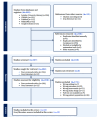Advancing Regional and Remote Health Care With Virtual Hospital Implementation: Rapid Review
- PMID: 40460425
- PMCID: PMC12174879
- DOI: 10.2196/64582
Advancing Regional and Remote Health Care With Virtual Hospital Implementation: Rapid Review
Abstract
Background: Disparities in health equity between metropolitan and rural areas are a global concern, especially in vast countries such as Australia, Canada, and the United States. Virtual care models in health care settings are promising in reducing inequalities, with virtual hospitals (VHs) potentially bridging the gap for isolated or underserved regions. However, evidence-based strategies and the complexities of VH implementation necessitate further research.
Objective: This rapid review aims to examine the role of VHs in enhancing regional and remote health care by focusing on accessibility, patient and health care provider experiences, and implementation barriers and facilitators. It provides tailored recommendations for large-scale implementation in communities with access issues, contributing to the discussion on equitable health care.
Methods: A rapid review was conducted in accordance with the World Health Organization guidelines. A systematic search was performed across PubMed, MEDLINE, CINAHL, and the La Trobe University Library for peer-reviewed articles published between January 2015 and March 2023. Additional gray literature was identified through Google searches and snowballing from relevant web articles. Studies were included if they focused on regional or remote populations and addressed VHs or virtual care. Studies that solely discussed hybrid models of care were excluded. Data were systematically extracted using a customized Microsoft Excel template. A mixed methods thematic analysis was conducted to identify recurring themes, barriers, facilitators, and recommendations related to VH implementation as well as patterns in clinical outcomes and stakeholder perspectives.
Results: A total of 35 articles were included in this review, comprising 23 (66%) peer-reviewed studies and 12 (34%) gray literature sources. Positive clinical outcomes were reported in 9 (26%) articles, highlighting outcomes such as reduced disease transmission, improved patient safety, fewer admissions and readmissions, lower mortality, shorter hospital stays, and better adherence to clinical best practices. Health system outcomes were identified in 15 (43%) articles, including reduced costs, enhanced patient experience and safety, improved care delivery and health care provider support, greater efficiency, broader geographic coverage, and better integration of services. Patient and health care provider perspectives were discussed in 12 (34%) articles, with positive views attributed to convenience, time and cost savings, and improved service quality. Barriers and facilitators were the most frequently discussed themes, appearing in 27 (77%) and 26 (74%) articles, respectively, with challenges and enablers commonly linked to people, processes, technology, and financial sustainability.
Conclusions: VHs have the potential to revolutionize regional and remote health care by overcoming barriers, using facilitators, and following recommended practices, leading to better clinical outcomes and increased satisfaction for patients and health care providers.
Keywords: barriers and facilitators; clinical outcomes; health care accessibility; health care provider perspectives; health system outcomes; patient experiences; recommendations; regional and remote health care; rural health care; telehealth; telemedicine; virtual care from home; virtual hospitals.
©Artika Archana Kumari, Tafheem Ahmad Wani, Michael Liem, James Boyd, Urooj Raza Khan. Originally published in JMIR Human Factors (https://humanfactors.jmir.org), 03.06.2025.
Conflict of interest statement
Conflicts of Interest: None declared.
Figures
Similar articles
-
Telehealth services in rural and remote Australia: a systematic review of models of care and factors influencing success and sustainability.Rural Remote Health. 2016 Oct-Dec;16(4):4268. Epub 2016 Nov 6. Rural Remote Health. 2016. PMID: 27817199
-
Telehealth services in rural and remote Australia: a systematic review of models of care and factors influencing success and sustainability.Rural Remote Health. 2016 Oct-Dec;16(4):3808. Epub 2016 Oct 17. Rural Remote Health. 2016. PMID: 27744708
-
Effect of Digital Care Platforms on Quality of Care for Oncological Patients and Barriers and Facilitators for Their Implementation: Systematic Review.J Med Internet Res. 2021 Sep 24;23(9):e28869. doi: 10.2196/28869. J Med Internet Res. 2021. PMID: 34559057 Free PMC article.
-
Hybrid Hospital-at-Home Program in Singapore: Ethnographic Study.J Med Internet Res. 2025 Jun 2;27:e66107. doi: 10.2196/66107. J Med Internet Res. 2025. PMID: 40456139 Free PMC article.
-
Facilitators of and Barriers to Accessing Hospital Medical Specialty Telemedicine Consultations During the COVID-19 Pandemic: Systematic Review.J Med Internet Res. 2023 Jul 10;25:e44188. doi: 10.2196/44188. J Med Internet Res. 2023. PMID: 37262124 Free PMC article.
References
-
- Dixit SK, Sambasivan M. A review of the Australian healthcare system: a policy perspective. SAGE Open Med. 2018;6:2050312118769211. doi: 10.1177/2050312118769211. https://journals.sagepub.com/doi/10.1177/2050312118769211?url_ver=Z39.88... 10.1177_2050312118769211 - DOI - DOI - PMC - PubMed
-
- Rural and remote health. Australian Institute of Health and Welfare, Australian Government. [2024-04-29]. https://www.aihw.gov.au/reports/rural-remote-australians/rural-and-remot... .
-
- Rechel B, Džakula A, Duran A, Fattore G, Edwards N, Grignon M, Haas M, Habicht T, Marchildon GP, Moreno A, Ricciardi W, Vaughan L, Smith TA. Hospitals in rural or remote areas: an exploratory review of policies in 8 high-income countries. Health Policy. 2016 Jul;120(7):758–69. doi: 10.1016/j.healthpol.2016.05.011. https://linkinghub.elsevier.com/retrieve/pii/S0168-8510(16)30127-0 S0168-8510(16)30127-0 - DOI - PubMed
-
- Thomas SL, Wakerman J, Humphreys JS. Ensuring equity of access to primary health care in rural and remote Australia - what core services should be locally available? Int J Equity Health. 2015 Oct 29;14:111. doi: 10.1186/s12939-015-0228-1. https://equityhealthj.biomedcentral.com/articles/10.1186/s12939-015-0228-1 10.1186/s12939-015-0228-1 - DOI - DOI - PMC - PubMed
-
- About rural health. Centers for Disease Control and Prevention (CDC) [2024-05-29]. https://www.cdc.gov/ruralhealth/about.html#:~:text=Rural%20Americans%20a... .
Publication types
MeSH terms
LinkOut - more resources
Full Text Sources
Medical
Miscellaneous




